2 福建师范大学地理研究所, 福建 福州 350007;
3 福建师范大学地理科学学院, 福建 福州 350007;
4 中国科学院地质与地球物理研究所, 中国科学院新生代地质与环境重点实验室, 北京 100029)
全新世发生的一系列持续数百年的气候震荡[1]是评估未来全球变暖背景下气候突变的重要参考,因此成为全球变化研究的热点之一。全新世气候突变事件最早由Denton和Karlén[2]研究山地冰川进退时提出,Bond等[3~4]在北大西洋深海沉积物中发现全新世存在9次类似于末次冰消期的冷事件。之后,北半球高纬度地区晚全新世冷事件获得广泛的证实,例如:Jennings等[5]发现格陵兰冰芯在2.4~3.8ka B.P.期间经历了高频的气候波动;通过对西苏格兰近海冷水珊瑚礁的研究,Douarin等[6]发现晚全新世存在数个珊瑚礁生长速率较慢的时期,其中包括1.75~2.80ka B.P.以及4.2ka B.P.;北美地区孢粉记录也发现了与北大西洋深海沉积物记录相似的9次气候事件[7]。在亚洲季风区,石笋氧同位素记录表明这些事件发生时夏季风减弱[8~12],云南西北部[13]、位于西周王朝发源地的关中盆地[14],以及北方季风区降水减少[15~17]。
基于各种频谱分析结果,许多研究认为太阳活动是全新世快速气候变化事件的驱动因子[4, 9, 18~20],但是也有研究指出并不是所有的全新世冷事件发生时太阳活动都显著的减弱,全新世不同时段的轨道参数和冰盖大小差异显著,这些气候事件无法用单一的驱动机制来解释[21]。相对于早全新世,晚全新世北极冰盖的影响要小的多,另外,太阳活动在“2.8ka”发生前后存在显著的负异常[22],因此“2.8ka”气候事件提供了一个研究晚全新世气候突变事件的太阳活动驱动机制的重要窗口。
东亚夏季风是大气环流中重要的一环,夏季风带来的降水支撑着东亚大量人口的生活和工农业生产,东亚夏季风如何响应北高纬的冷事件成为重要的科学议题之一。虽然东亚季风区许多记录都显示“2.8ka”气候事件的存在[8~10, 13~17],但是高分辨率并且精确定年的气候记录并不多。在研究气候事件的持续时间、内部构造以及驱动机制方面,基于230 Th定年的高分辨石笋记录具有自己的优势,已经被广泛用于探讨末次冰期以来气候突变事件的精细过程[11~12, 23~26]。最近,湖北永兴洞[27]、贵州董哥洞[9, 28]和贵州七星洞[29]相继发表了高分辨率的石笋氧同位素记录,针对2.8ka气候事件的详细变化过程和驱动机制做了深入的探讨;但是,这些记录主要来自长江流域以南地区,而对季风降水更为敏感的北方地区尚缺少可靠的高分辨石笋记录。本文基于辽宁庙洞石笋氧同位素序列,重建这个地区“2.8ka”气候事件前后夏季风的详细过程,对比了“2.8ka”气候事件中国东部南北方石笋记录的异同,进而对“2.8ka”气候事件的太阳活动驱动机制进行了一些探讨。
1 研究区域和洞穴概况 1.1 区域概况本溪庙洞位于对季风降水更为敏感的中国北方(图 1)辽宁省本溪市桓仁县境内。桓仁县属辽东山地丘陵区,鸭绿江的支流浑江是境内的主要河流。本区属于中温带湿润季风气候区,四季分明,根据1953~2012年气象数据统计,年均温度为7.4℃,最冷1月平均气温为-12.4℃,最热7月平均气温为22. 9℃[30]。1953~2010年,桓仁县年降水量为578~1451mm,多年平均降水量883mm,降水在全年均有分布,但是6~8月降水量占全年的65 % [31]。
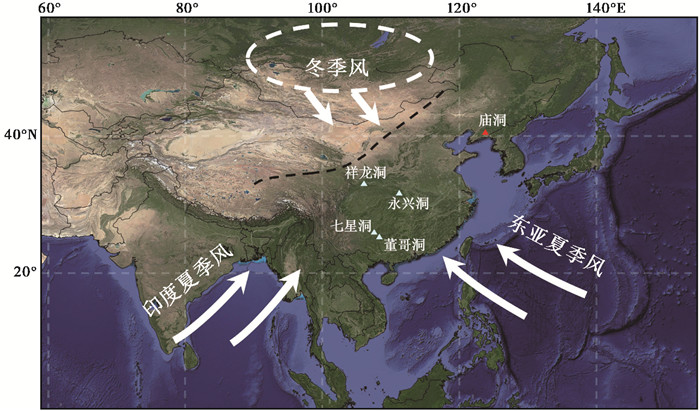
|
图 1 辽宁本溪庙洞地理位置示意图(红色三角形),黑色虚线表示现代东亚夏季风界线[32] Fig. 1 Schematic map showing location of Miaodong Cave(red triangle), the black dashed line indicates the modern East Asian Summer Monsoon limit[32] |
桓仁县处于长白山与华北两大植物区系过渡带,森林资源丰富,植被为针叶-落叶阔叶林混交林[32~33]。主要树种为柞树(Xylosma racemosum)、红松(Pinus koraiensis Sieb. et Zucc.)、落叶松(Larix gmelinii(Rupr.)Kuzen.)、云杉(Picea asperata Mast.)等[33]。
1.2 洞穴概况庙洞(41°03′N,125°31′E)洞口海拔193m。洞穴发育于奥陶系和寒武系碳酸盐岩地层中,上覆岩层厚度约30~70m。洞穴上覆植被以次生落叶阔叶林为主,见有落叶松和油松零星分布[34]。
庙洞为典型流出型喀斯特洞穴,整个洞穴呈近南北向展布,已探明洞道总长约500m。洞口为深约10m,宽5~8m的长方形厅堂,曾建有庙宇,庙洞由此得名。厅堂之后的洞道突然收窄,须匍匐爬行方可进入,狭长洞道长约100m,之后洞道较为宽敞,断断续续可见地下河。雨季地下河水抬升,河水淹没狭长洞道,没有特殊设备辅助,无法进入洞穴。庙洞洞道多为裂缝式和廊道状,没有大的厅堂,洞道宽度一般为1~10m,洞道高度则变化较大,高处超过20m,最矮处不足1m。庙洞支洞不甚发育,且都较短而闭塞。洞内次生碳酸盐沉积发育,但种类较单一,多为流水沉积和滴水沉积,人为破坏严重。
2012~2013年洞穴监测数据显示,洞穴空气温度稳定在11.5℃上下,相对湿度常年大于95 %,基本上没有显著的季节变化[34]。观测期间,不同滴率的滴水点之间,其δ18O值在测试误差范围内基本相同;滴水δ18O值季节性变化也很小(小于0.2 ‰),维持在-9.6 ‰ (VSMOW)上下波动,与洞外夏季(6~9月)降水氧同位素的加权平均值相当,说明洞穴上覆土壤层和表层喀斯特系统调蓄能力较强,混合较均匀,庙洞滴水氧同位素组成继承了夏季大气降水氧同位素变化[34]。
2 材料与方法研究石笋样品MD12采集自距离洞口约400m的支洞中,该支洞环境稳定,空气湿度常年大于95 % [34]。MD12石笋表面洁净,未见风化现象,长约169mm。沿生长轴切开,经抛光、清洗和常温烘干后,石笋纵剖面在自然光下呈棕黄色至乳白色,半透明,岩性致密,未见溶孔或风化现象(图 2),矿物鉴定显示石笋由纯方解石组成,纹理总体呈平顶箱状。MD12石笋在距顶97mm处存在明显的沉积间断面(图 2),定年结果显示间断面上、下生长时段分别约为0.39~0.90ka B.P.和2.60~2.92ka B.P.,本文就距顶97mm处间断面之下的时段开展研究。另外,为了便于与其他记录对比,集成了庙洞另外一支石笋MD11的氧同位素序列[35],MD11石笋生长具有明显的阶段性,其中2.90~3.04ka B.P.时段沉积速率较高,这样将庙洞记录延长至3.04ka B.P.。
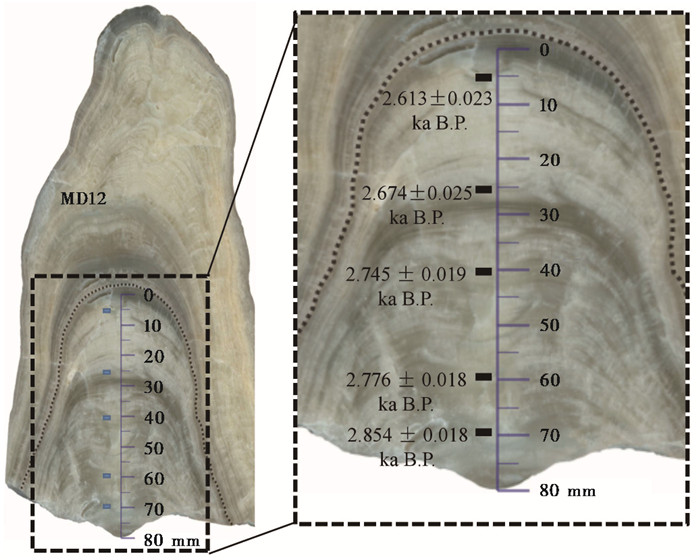
|
图 2 石笋MD12纵剖面扫描图 图中小方块示意定年点,黑色虚弧线表示沉积间断面 Fig. 2 Polished sections of stalagmite MD12.The black rectangles indicate the positions of sub-samples for dating, and the black dash line indicate the depositional hiatus |
在石笋抛光面上,使用直径0.7mm牙钻沿石笋层理钻取5个粉末样品,供MC-ICP-MS-230 Th测年分析,每个样品重约0.10~0.15g,样品点采样槽厚约1mm。实验在中国科学院地质与地球物理研究所完成。测试分析方法如文献[36]所述。
碳氧稳定同位素分析样品使用直径为0.5mm的牙钻采集,沿石笋生长轴以1mm间隔钻取粉末样80个,每个粉末样重约150~200μg。另外,选择两个深度,沿纹理方向各采集5个样品,共10个粉末样品,供亨利同位素分馏平衡检测(“Hendy Test”[37])。碳氧稳定同位素比值采用美国Thermo-Finnigen公司生产的Gas Bench-Ⅱ型碳酸盐反应装置与MAT 253型同位素比值质谱仪联机在线测定,每6个样品内插1个实验室标样(CAI13),实验室标样和参考气使用NBS-19标定。数据采用VPDB标准,分析内精度一般优于0.1 ‰,外精度优于0.2 ‰。实验在福建师范大学稳定同位素中心完成。
3 研究结果 3.1 铀钍定年及时间标尺表 1列出研究石笋MD12的U、Th含量和MC- ICP-MS-230 Th年龄。在所有5个样品中,除了个别样品,U含量大多在150×10-9g/g左右;年龄误差(±2σ)介于18年至25年之间。
| 表 1 庙洞石笋MD12的U、Th同位素含量和MC-ICP-MS-230Th年龄 Table 1 U and Th isotopic compositions, and 230Th ages of the stalagmite MD12 from Miaodong Cave by MC-ICP-MS |
年龄随深度变化如图 3所示,石笋的年代标尺采用线性内插和外推法,石笋MD12研究时段约为2.60ka B.P.至2.92ka B.P.。年龄控制点间的平均年生长速率介于0.13mm至0.58mm之间,平均为0.24mm(图 3)。

|
图 3 石笋MD12年龄模式和平均生长速率水平误差表示2σ年龄误差 Fig. 3 Age model for stalagmite MD12 and stage averaged growth rate curve. The error bars indicate 2σ age error |
石笋MD12氧同位素值介于-9.71 ‰与-7.59 ‰之间变化,平均值为-8.58 ‰。图 4为庙洞石笋氧同位素时间序列,结果显示出显著的年代际-百年尺度变化,变化幅度达到1.5 ‰。整个序列有两个较为明显的同位素正偏阶段:第一次发生在大约2.81~2.87ka B.P.时段(W1),持续时间约60年,幅度相对小一些;第二次发生于约2.76~2.66ka B.P.时段(W2),呈近对称的“V”字型,前后持续了约110年左右,波动幅度超过1.2 ‰,这个阶段内部还有显著的次一级波动,谷底有两个极值点,分别发生于2.71ka B.P.和2.68ka B.P.。两个同位素正偏阶段之间是一个持续时间约为50年的同位素负偏阶段,从2.88~2.62ka B.P.,序列呈三峰夹二谷的“W”型结构。
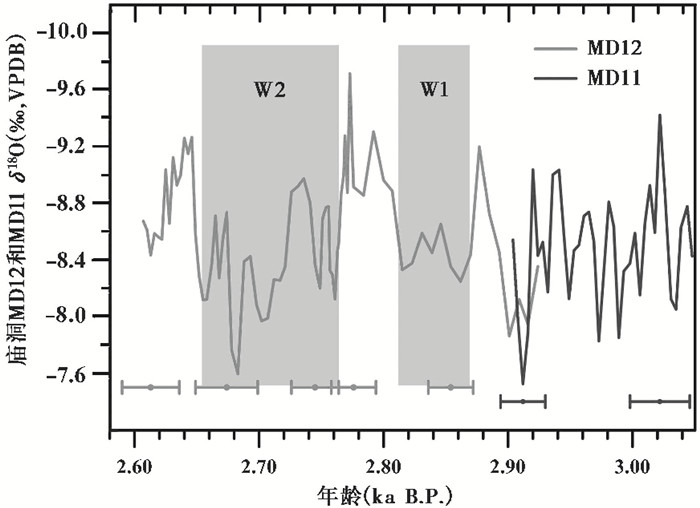
|
图 4 庙洞石笋MD12(灰色)和MD11[35] (黑色)氧同位素时间序列 竖直灰色阴影区表示两次同位素正偏阶段(W1和W2),误差棒表示2σ年龄误差 Fig. 4 Time sequences of oxygen isotope in stalagmite MD12(gray curce)and MD11[35](black curce)from Miaodong Cave.The gray rectangles indicate two intervals (W1 and W2)of positive excursion of δ18O. The error bars show the 2σ age error |
利用石笋氧同位素研究气候变化首先必须确定石笋碳酸钙是否在同位素平衡条件下沉积的。庙洞为典型的流出性洞穴,唯一的天然洞口仅容一个人匍匐进入,洞内常年有地下水,样品采集洞道狭小闭塞,多年实测空气温度基本稳定在约11.5℃,湿度大于95 %,说明洞穴封闭,空气闭塞且潮湿,沉积环境有利于滴水碳酸盐氧同位素平衡分馏。根据滴水沉积氧同位素平衡性实测数据分析[34],该洞穴石笋氧同位素基本上是平衡分馏的,滴水沉积氧同位素季节性变化小于0.5 ‰,远小于研究石笋中1.5 ‰的年代际变化幅度。Hendy检验[37]结果(图略)显示同一纹层碳氧同位素并没有明显从中间往两边变重的趋势,碳氧同位素之间无显著相关关系,也证明研究石笋氧同位素变化受动力分馏效应影响较小。
在同位素平衡分馏沉积下,石笋氧同位素值主要受控于滴水同位素组成和洞穴温度[37]。多年洞穴观测结果显示庙洞洞穴温度常年稳定,基本没有季节性变化[34],因此洞穴温度反映的是长周期的年均温变化,而温度对石笋δ18O的影响较小(-0.24 ‰ /℃[38]),庙洞石笋MD11和MD12氧同位素序列在年代际尺度上,变化幅度高达1.5 ‰,这显然无法完全用温度来解释,因此,庙洞石笋MD11和MD12氧同位素变化主要受控于滴水的氧同位素组成变化。
降水的氧同位素组成受控于水汽源区的平均气候状况、水汽输送模式及其在输送过程中的降水历史[39]。庙洞地处东北亚季风区,是东亚夏季风的尾闾区和东亚冬季风的前沿区,受来自西伯利亚的冷干气流(冬季风)和来自东南方向的暖湿气流(夏季风)季节性交替控制。每年5~6月,随着海陆温度梯度的增大,在赤道太平洋和印度洋形成巨大的季风环流,随后,其季风环流不断扩大,北界不断向北跃进,每年7~8月到达研究区所在的华北和东北,给本地区带来大量降雨[40]。季风环流在向内陆运移过程中,沿途不断有水汽从汽团中移出,使得水汽逐渐亏损18 O,这种季风环流及其降雨历史掩盖了温度效应和低纬度地区普遍存在雨量效应[39],即部分学者提出的环流效应[41~42]。夏季风降水的δ18O值主要受水汽从赤道太平洋和印度洋向研究地点输送过程中移出比例影响,水汽输送距离越远,沿途水汽移出比例越高,到达研究地点的降水δ18O值越负[43]。进入秋季,随着夏季风的退却,冬季风开始增强,并逐渐控制东亚地区,直到次年春季,这期间降水较少,以降雪为主,δ18O值较雨季显著偏负。根据现代观测资料,全年65 %以上的降水集中于夏季风盛行的6~8月[31],洞穴观测资料分析表明降雪对于庙洞滴水的补给有限,庙洞滴水氧同位素主要继承了当地雨季降水氧同位素组成[34]。研究区地处亚洲夏季风的东北缘,季风增强时,不仅夏季风降水的δ18O值由于受季风环流及其降水历史影响而变负,而且降雨量也会增加[44],其占全年降水比重增大,反之亦然。这两种同位素变化机制的同向变化,使得研究区降水对东亚季风变化更加敏感,这也部分解释了MD11和MD12的δ18O序列较其他洞穴更大幅度的高频震荡。
综上所述,MD11和MD12的δ18O值主要指示夏季风强弱(或夏季风降水多少)变化,δ18O值变负表明夏季风增强,辽东地区夏季风降水量增大,相反,δ18O值偏正表示当时夏季风减弱,辽东地区夏季降水减少。
4.2 2.8ka事件的南北石笋记录对比庙洞石笋氧同位素在2.76ka B.P.快速正偏,说明东亚夏季风突然变弱,这种弱季风气候持续了约110年,到约2.66ka B.P.夏季风才迅速回升,期间有两次明显的次一级波动,夏季风最弱也是该事件的中心时间大约发生在约2.68ka B.P.,最临近的年代控制点定年结果为2.674±0.025ka B.P.,事件结束时间也有高精度230 Th年龄控制,即2.613±0.023ka B.P.,因此,庙洞石笋MD12氧同位素记录的2.8ka事件的中心点年龄可以估计为2.68ka B.P.,事件的核心时段起止时间约为2.76~2.66ka B.P.(图 4和图 5中W2阶段)。如果将这之前的一次弱季风亚阶段(图 4和图 5中W1)一起考虑,则整个2.8ka事件呈现三峰夹二谷的“W”型,起止时间分别为2.88ka B.P.和2.64ka B.P.。王绍武等[13]根据历史文献的研究也发现2.8~2.7ka B.P.时段在临渭盆地等地气候干旱。与太阳活动总辐射量(ΔTSI)相比[22],庙洞石笋氧同位素记录的2.8ka事件核心时段正好对应着太阳活动的极小期(图 5)。
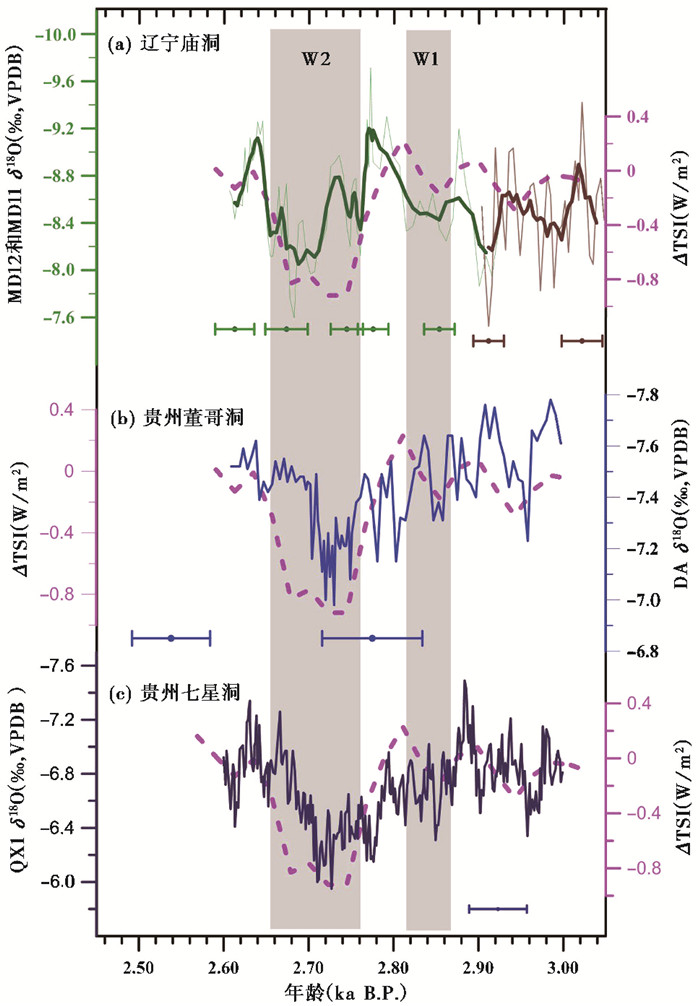
|
图 5 庙洞石笋氧同位素记录的2.8ka事件(a,粗实线为5点平滑曲线)与董哥洞石笋DA氧同位素[9] (b)和七星洞石笋QX1氧同位素记录[29] (c)以及太阳辐射值[22](紫色虚线)对比图 竖直灰色阴影区表示弱季风时段(W1和W2),误差棒表示2σ年龄误差 Fig. 5 Stalagmite δ18O sequences from Miaodong Cave (a, the bold line shows 5 points smooth fit), compared with those from Dongge Cave[9](b), Qixing Cave[29](c)and total solar irradiance (ΔTSI)[22], showing detail of "2.8ka" failure monsoon event and its robust correlation with solar activity.The gray rectangles indicate two intervals of failure monsoon(W1 and W2). The error bars show the 2σ age error |
对比贵州董哥洞石笋DA氧同位素记录和贵州七星洞石笋QX1氧同位素记录(图 5),在2.8ka事件发生的中心点时间上,庙洞石笋氧同位素记录(2.68ka B.P.)要稍微晚于早前发表的董哥洞石笋DA氧同位素记录[9]和七星洞石笋QX1氧同位素记录(约2.71ka B.P.)[29]。考虑记录的年代误差,南北方石笋氧同位素记录基本一致。但是,庙洞石笋氧同位素记录与贵州石笋DA[9]和QX1[29]氧同位素记录在事件的开始阶段则存在显著的差异,庙洞石笋氧同位素记录在2.81~2.76ka B.P.期间存在一次明显的季风增强时段(图 5),这个阶段不仅氧同位素显著负偏,而且石笋生长速率也是石笋MD12中最大的(图 3),从2.76ka B.P.夏季风突然减弱。这个峰值在贵州石笋氧同位素记录中不明显[9](图 5),因此贵州石笋氧同位素记录中2.8ka事件的开始时间较庙洞石笋氧同位素记录早了约100年,整个事件呈不对称的“V”字型,即季风强度缓慢变弱,快速回升的特征。南北石笋氧同位素记录之间的这种差异到底是区域气候不同,还是石笋氧同位素气候信号不确定性,抑或是石笋沉积连续性或者年代误差引起,还需要更多可靠年龄控制的高分辨古气候数据验证。
另外,需要注意的是,贵州董哥洞另一支石笋DAS氧同位素记录[28]和湖北永兴洞石笋氧同位素记录[27],以及陕南祥龙洞石笋氧同位素记录[45]与庙洞石笋氧同位素记录、董哥洞石笋DA氧同位素记录[9]和七星洞QX1石笋氧同位素记录[29]差异显著,这种差异除了年代误差外,也可能是石笋对气候响应不同,抑或是受其他因素干扰,如沉积的连续性或(和)动力分馏等。
4.3 2.8ka事件的驱动机制探讨海气系统耦合作用、大洋环流的内部作用以及温盐环流以及ENSO等都有可能在百年尺度气候事件上起着重要作用[46]。对于全新世一系列准千年周期的百年尺度气候变化,普遍观点认为由太阳活动驱动[4, 7~9, 27~29],也有一些观点认为太阳活动不是唯一驱动因素,还存在其他因素的共同作用[21, 47~48]。Risebrobakken等[49]的研究认为北欧海域的气候变化与太阳辐射变化没有明显的对应关系,而应该是受到海气系统耦合以及温盐环流的影响;除此之外,O'Brien等[1]曾提出北极涡流的扩大、经向环流增强或北半球高中纬气温的变化都有可能是气候突变事件的诱因。在局部地区,海气系统或地表植被的反馈机制、火山活动等可能成为主要影响因素[21]。与全新世早期的气候波动可能受冰量的影响不同[50],发生在晚全新世的2.8ka事件受北极冰盖的影响相对较小[51]。另外,太阳活动代用指标[22, 52]显示,2.8ka事件对应着一次全新世最为确切和显著的太阳活动极小期,这为验证太阳活动与亚洲季风气候变化的关系提供一个很好的例子。这一时期的太阳总辐照度[22]如图 5和图 6中紫色虚线所示,与庙洞石笋MD12氧同位素的记录在快速变化的起止时间和过程都吻合的非常好,这说明太阳活动可能是2.8ka事件发生的触发因子,并且是通过快速的动力学驱动机制影响东亚地区的气候变化。
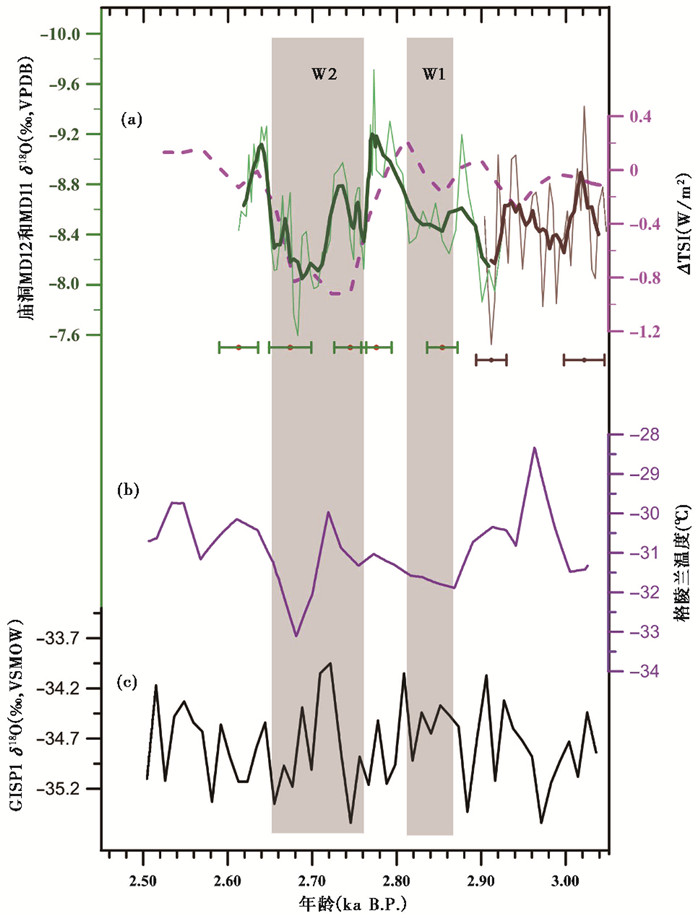
|
图 6 庙洞石笋氧同位素序列(a,粗实线为5点平滑曲线,误差棒表示2σ年龄误差)与太阳活动总辐射量[22](a,紫色虚线)、格陵兰温度[53] (b)及格陵兰冰芯GISP2氧同位素[54] (c)对比 灰色阴影区表示庙洞记录中的两个弱季风阶段(W1和W2) Fig. 6 Comparisons among MD oxygen sequences(a, the bold line shows 5 point smooth fitting. The error bars indicate 2σ age error), solar activity indexes(ΔTSI[22])(a, dash line), Greenland temperature[53](b)and GISP2 oxygen record[54](c).Gray bars are corresponded to weak monsoon intervals(W1 and W2)in Miaodong Cave record |
虽然有观点认为太阳活动的微小过程不足以引起如此大的气候波动[55],但是,太阳活动的作用可能经大洋环流放大[11]或者大气遥相关[12]而影响全球气候。“2.8事件”发生时期,虽然格陵兰冰芯中氧同位素变化不明显,但是基于冰芯氩和氮同位素重建的格陵兰温度的确有一次显著的降温事件[52~53](图 6),另外北半球高纬度地区普遍记录到这一快速变冷事件,例如,北大西洋冰漂碎屑事件[3]和阿尔卑斯山地区的冰进事件[2]。Zhang等[29]基于贵州七星洞QX1石笋记录中2.8ka事件与8.2ka事件具有类似的东亚夏季风缓慢减弱,快速增强的不对称Ⅴ字型结构,认为2.8ka事件由太阳活动触发,北大西洋经向环流减弱,从而导致亚洲季风减弱。庙洞石笋氧同位素记录与太阳活动变化对比结果(图 5和6)显示二者在年代误差范围内同步变化,在事件的核心阶段(W2)呈近对称“V”字型结构。南北石笋氧同位素记录之间的这种差异到底是区域气候不同,还是石笋氧同位素气候信号不确定性,抑或是石笋沉积连续性或者年代误差引起,还需要更多可靠年龄控制的高分辨古气候数据验证。但是,从辽宁庙洞石笋氧同位素记录来看,2.8ka事件东亚夏季风减弱可能是由太阳活动减弱触发,导致北大西洋地区和北半球高纬度地区温度降低,并通过大气遥相关机制影响亚洲夏季风。
5 结论通过高精度定年和碳氧稳定同位素分析,重建了3.04~2.60ka B.P.辽宁本溪庙洞石笋氧同位素序列,该序列记录了2.8ka事件发生时东亚夏季风(降水)变化的详细过程。在2.88~2.62ka B.P.时段,东亚夏季风呈现三峰两谷的“W”结构,两个弱季风时段分别为2.81~2.87ka B.P.和2.76~2.66ka B.P.,后者为2.8ka事件的核心时段,持续时间大约110年,氧同位素波动幅度超过1.2 ‰,呈“V”字型近对称结构,谷底有两个极值点,分别为2.71ka B.P.和2.68ka B.P.,其中2.68ka B.P.前后为夏季风最弱的时候,即2.8ka事件的中心点。庙洞石笋氧同位素记录的2.8ka弱季风事件对应着太阳活动极小期和北半球高纬度的冷事件,支持太阳活动驱动的观点。庙洞石笋氧同位素记录快速响应太阳活动的变化特征,说明其驱动机制可能与大气遥相关作用有关。
致谢: 感谢美国明尼苏达大学地质与地球物理系Edwards R. L.和Cheng Hai教授在样品顶底年龄测试中提供的帮助;审稿专家和编辑部杨美芳老师提出宝贵的修改意见,在此一并感谢!
| [1] |
O'Brien S R, Whitlow S I, Meeker L D, et al. Complexity of Holocene climate as reconstructed from a Greenland ice core[J]. Science, 1995, 270(5244): 1962-1964. DOI:10.1126/science.270.5244.1962 |
| [2] |
Denton G H, Karlén W. Holocene climatic variations-Their pattern and possible cause[J]. Quaternary Research, 1973, 3(2): 155-174. DOI:10.1016/0033-5894(73)90040-9 |
| [3] |
Bond G, Showers W, Cheseby M, et al. A pervasive millennial-scale cycle in North Atlantic Holocene and glacial climates[J]. Science, 1997, 278(7): 2402-2415. |
| [4] |
Bond G, Kromer B, Beer J, et al. Persistent solar influence on North Atlantic climate during the Holocene[J]. Science, 2001, 294(5549): 2130-2136. DOI:10.1126/science.1065680 |
| [5] |
Jennings A E, Knudsen K L, Hald M, et al. A mid-Holocene shift in Arctic sea-ice variability on the East Greenland Shelf[J]. The Holocene, 2002, 12(1): 49-58. DOI:10.1191/0959683602hl519rp |
| [6] |
Douarin M, Elliot M, Noble S R, et al. Growth of north-east Atlantic cold-water coral reefs and mounds during the Holocene:A high resolution U-series and14C chronology[J]. Earth and Planetary Science Letters, 2013, 375(12): 176-187. |
| [7] |
Viau A E, Gajewski K, Fines P, et al. Widespread evidence of 1500 yr climate variability in North America during the past 14000 yr[J]. Geology, 2002, 30(5): 455-458. DOI:10.1130/0091-7613(2002)030<0455:WEOYCV>2.0.CO;2 |
| [8] |
Fleitmann D, Burns S, Mudelsee M, et al. Holocene forcing of the Indian monsoon recorded in a stalagmite from Southern Oman[J]. Science, 2003, 300(5626): 1737-1739. DOI:10.1126/science.1083130 |
| [9] |
Wang Y J, Cheng H, Edwards R L, et al. The Holocene Asian monsoon:Links to solar changes and North Atlantic climate[J]. Science, 2005, 308(5723): 854-857. DOI:10.1126/science.1106296 |
| [10] |
Hu C Y, Henderson G M, Huang J, et al. Quantification of Holocene Asian monsoon rainfall from spatially separated cave records[J]. Earth and Planetary Science Letters, 2008, 266(3-4): 221-232. DOI:10.1016/j.epsl.2007.10.015 |
| [11] |
Cheng H, Fleitmann D, Edwards R L, et al. Timing and structure of the 8.2 kyr B. P. event inferred from δ18O records of stalagmites from China, Oman, and Brazil[J]. Geology, 2009, 37(11): 1007-1010. DOI:10.1130/G30126A.1 |
| [12] |
Liu Y H, Henderson G M, Hu C Y, et al. Links between the East Asian monsoon and North Atlantic climate during the 8, 200 year event[J]. Nature Geoscience, 2013, 6(2): 117-120. DOI:10.1038/ngeo1708 |
| [13] |
罗文磊, 常洁, 孙伟伟, 等. 过去约8000年来程海摇蚊组合记录的气候与环境变化[J]. 第四纪研究, 2018, 38(4): 864-873. Luo Wenlei, Chang Jie, Sun Weiwei, et al. A 8000-year climate and environmental record inferred from subfossil chironomids from Chenghai Lake, Southwestern China[J]. Quaternary Sciences, 2018, 38(4): 864-873. |
| [14] |
王绍武, 黄建斌, 闻新宇, 等. 4-2 ka BP中国干旱的证据和模拟研究[J]. 科学通报, 2008, 53(20): 2428-2433. Wang Shaowu, Huan Jianbin, Wen Xinyu, et al. Evidence and modeling study of droughts in China during 4-2 ka BP[J]. Chinese Science Bulletin, 2008, 53(14): 2215-2221. |
| [15] |
申改慧, 丁国强, 阳小兰, 等. 白洋淀地区全新世以来的气候环境变化[J]. 第四纪研究, 2018, 38(3): 756-768. Shen Gaihui, Ding Guoqiang, Yang Xiaolan, et al. Holocene climate and environmental change in the Baiyangdian area[J]. Quaternary Sciences, 2018, 38(3): 756-768. |
| [16] |
贾飞飞, 鲁瑞洁, 高尚玉. 毛乌素沙漠东南缘湖沼相沉积物粒度特征记录的12.2 cal.ka B. P.以来的区域环境变化[J]. 第四纪研究, 2018, 38(5): 1211-1220. Jia Feifei, Lu Ruijie, Gao Shangyu. Environmental changes recorded from grain-size characteristics of the lacustrine-peat sediments from southeastern margin of Mu Us Desert since 12.2 cal.ka B. P.[J]. Quaternary Sciences, 2018, 38(5): 1211-1220. |
| [17] |
韩鹏, 刘兴起. 内蒙古中东部查干淖尔湖流域7000年以来的气候演变[J]. 第四纪研究, 2017, 37(6): 1381-1390. Han Peng, Liu Xingqi. The climate evolution inferred from Chagan-Nuur in middle-east part of Inner Mongolia since the last 7000 years[J]. Quaternary Sciences, 2017, 37(6): 1381-1390. |
| [18] |
严银汉, 孔兴功, 汪永进, 等. 基于小波分析的全新世气候千年周期及其成因[J]. 第四纪研究, 2012, 32(2): 294-303. Yan Yinhan, Kong Xinggong, Wang Yongjin, et al. Holocene climate millennium cycle and causes based on wavelet analysis[J]. Quaternary Sciences, 2012, 32(2): 294-303. DOI:10.3969/j.issn.1001-7410.2012.02.15 |
| [19] |
黄春菊, 田晓丽. 太阳活动对年代际-亚轨道尺度气候变化的驱动机制探讨[J]. 第四纪研究, 2018, 38(5): 1255-1267. Huang Chunju, Tian Xiaoli. Discussion on the driving mechanism of solar activity to interannual-suborbital-scale climate change[J]. Quaternary Sciences, 2018, 38(5): 1255-1267. |
| [20] |
张志平, 黄伟, 陈建徽, 等. 全新世东亚夏季风演化的多尺度周期变化及其可能机制探讨[J]. 第四纪研究, 2017, 37(3): 498-509. Zhang Zhiping, Huang Wei, Chen Jianhui, et al. Multi-time scale analysis of East Asian Summer Monsoon and its possible mechanism during Holocene[J]. Quaternary Sciences, 2017, 37(3): 498-509. |
| [21] |
Wanner H, Solomina O, Grosjean M, et al. Structure and origin of Holocene cold events[J]. Quaternary Science Reviews, 2011, 30(21-22): 3109-3123. DOI:10.1016/j.quascirev.2011.07.010 |
| [22] |
Steinhilber F, Abreu J A, Beer J, et al. 9400 years of cosmic radiation and solar activity from ice cores and tree rings[J]. Proceedings of the National Academy of Sciences of the United States of America, 2012, 109(16): 5967-5971. DOI:10.1073/pnas.1118965109 |
| [23] |
董进国, 赵侃, 沈川洲, 等. 黄土高原石笋记录的DO 25季风增强事件[J]. 第四纪研究, 2016, 36(6): 1502-1509. Dong Jinguo, Zhao Kan, Shen Chuan-Chou, et al. Strong East Asian summer monsoon during the DO 25 event recorded by an absolute-dated stalagmite from Dragon Cave, Northern China[J]. Quaternary Sciences, 2016, 36(6): 1502-1509. |
| [24] |
孙喜利, 杨勋林, 史志超, 等. 石笋记录的西南地区MIS 4阶段夏季风的演化[J]. 第四纪研究, 2017, 37(6): 1370-1380. Sun Xili, Yang Xunlin, Shi Zhichao, et al. The evolution of summer monsoon in Southwest China during MIS 4 as revealed by stalagmite δ18O record[J]. Quaternary Sciences, 2017, 37(6): 1370-1380. |
| [25] |
王权, 汪永进, 刘殿兵, 等. DO 3事件的湖北神农架高分辨率年纹层石笋记录[J]. 第四纪研究, 2017, 37(1): 108-117. Wang Quan, Wang Yongjin, Liu Dianbing, et al. The DO 3 event in Asian monsoon climates evidenced by an annually laminated stalagmite from Qingtian Cave, Mt. Shennongjia[J]. Quaternary Sciences, 2017, 37(1): 108-117. |
| [26] |
崔梦月, 洪晖, 孙晓双, 等. 福建仙云洞石笋记录的新仙女木突变事件结束时的缓变特征[J]. 第四纪研究, 2018, 38(3): 711-719. Cui Mengyue, Hong Hui, Sun Xiaoshuang, et al. The gradual change characteristics at the end of the Younger Dryas event inferred from a speleothem record from Xianyun Cave, Fujian Province[J]. Quaternary Sciences, 2018, 38(3): 711-719. |
| [27] |
李伟, 陈仕涛, 吴帅男, 等. 东亚季风2.8 ka事件高分辨率的石笋记录[J]. 第四纪研究, 2014, 34(6): 1256-1263. Li Wei, Chen Shitao, Wu Shuainan, et al. A high resolution East Asian Monsoon record around 2.8 ka B. P. from Mt. Shennongjia, Central China[J]. Quaternary Sciences, 2014, 34(6): 1256-1263. |
| [28] |
Duan F C, Wang Y J, Shen C C, et al. Evidence for solar cycles in a Late Holocene speleothem record from Dongge Cave, China[J]. Scientific Reports, 2014, 4(7503): 182-182. |
| [29] |
Zhang Z Q, Wang Y J, Liu D B, et al. Multi-scale variability of the Asian monsoon recorded in an annually-banded stalagmite during the Neoglacial from Qixing Cave, Southwestern China[J]. Quaternary International, 2017, 487: 78-86. DOI:10.1016/j.quaint.2017.08.072 |
| [30] |
赵雷, 吉奇, 林双, 等. 1953-2012年桓仁县气温与蒸发量变化特征及趋势分析[J]. 现代农业科技, 2015(3): 226-228. Zhao Lei, Ji Qi, Lin Shuang, et al. Aanalysis on variation characteristics and trend of temperature and evaporation in Huanren County from 1953 to 2012[J]. Modern Agricultural Science and Technology, 2015(3): 226-228. DOI:10.3969/j.issn.1007-5739.2015.03.137 |
| [31] |
高博, 吉奇, 孙雪, 等. 近58年桓仁县暖干化趋势与土壤蒸发量特征分析[J]. 安徽农业科学, 2014, 42(24): 8289-8290. Gao Bo, Ji Qi, Sun Xue, et al. Analysis on warming and drying trends and characteristics of soil evaporation in Huanren County in recent 58 years[J]. Journal of Anhui Agricultural Sciences, 2014, 42(24): 8289-8290. DOI:10.3969/j.issn.0517-6611.2014.24.074 |
| [32] |
Wright H E. Global climates since the last glacial maximum[M]//Winkler M G, Wang P K. The Late Quaternary Vegetation and Climate of China. Minneapolis: University of Minnesota Press, 1993: 221-261.
|
| [33] |
陈树培, 董世林.中国植被及其地理格局[M]//张新时.中华人民共和国植被图(1: 1000000)说明书.北京: 地质出版社, 2007: 182-187. Chen Shupei, Dong Shilin. Vegetation of China and its geographic pattern[M]//Zhang Xinshi(Editor in Chief). Illustration of the Vegetation Map of the People's Republic of China(1: 1000000). Beijing: Geological Publishing House, 2007: 182-187. |
| [34] |
王芳, 孙青, 蔡炳贵, 等. 辽宁本溪庙洞降水、滴水和现生碳酸钙的δ18O变化特征及其古气候意义[J]. 第四纪研究, 2016, 36(6): 1370-1382. Wang Fang, Sun Qing, Cai Binggui, et al. Variation of δ18O in the meteoric precipitation, drip water and their calcite deposition in Miaodong Cave, Liaoning Province and its implications for palaeoclimate reconstructions[J]. Quaternary Sciences, 2016, 36(6): 1370-1382. |
| [35] |
闫禹, 王芳, 蔡炳贵, 等. 辽宁本溪庙洞石笋氧同位素记录的距今4-3千年东亚夏季风演化历史[J]. 亚热带资源与环境学报, 2017, 12(1): 19-25. Yan Yu, Wang Fang, Cai Binggui, et al. Variability in East Asian summer monsoon during 4-3 ka B. P. recorded by stalagmite δ18O sequence from Benxi, Liaoning Province[J]. Journal of Subtropical Resources and Environment, 2017, 12(1): 19-25. DOI:10.3969/j.issn.1673-7105.2017.01.004 |
| [36] |
Cheng H, Edwards R L, Shen C C, et al. Improvements in 230Th dating, 230Th and234U half-life values, and U-Th isotopic measurements by multi-collector inductively coupled plasma mass spectrometry[J]. Earth and Planetary Science Letters, 2013, 371-372: 82-91. DOI:10.1016/j.epsl.2013.04.006 |
| [37] |
Hendy C H. The isotopic geochemistry of speleothems-Ⅰ. The calculation of the effects of different modes of formation on the isotopic composition of speleothems and their applicability as palaeoclimatic indicators[J]. Geochimica et Cosmochimica Acta, 1971, 35(8): 801-824. DOI:10.1016/0016-7037(71)90127-X |
| [38] |
Kim S T, O'Neil J R. Equilibrium and nonequilibrium oxygen isotope effects in synthetic carbonates[J]. Geochimica et Cosmochimica Acta, 1997, 61(16): 3461-3475. DOI:10.1016/S0016-7037(97)00169-5 |
| [39] |
Araguás-Araguás L, Froehlich K, Rozanski K. Stable isotope composition of precipitation over Southeast Asia[J]. Journal of Geophysical Research:Atmospheres, 1998, 1032(D22): 28721-28742. |
| [40] |
Tao S Y, Chen L X. A review of recent research on the East Asian summer monsoon in China[M]//Chang C P, Krishnamurti T N. Monsoon Meteorology. Oxford, UK: Oxford University Press, 1987: 60-92.
|
| [41] |
谭明. 环流效应:中国季风区石笋氧同位素短尺度变化的气候意义——古气记录与现代气候研究的一次对话[J]. 第四纪研究, 2009, 29(5): 851-862. Tan Ming. Circulation effect:Climatic significance of the short term variability of the oxygen isotopes in stalagmites from monsoonal China-Dialogue between paleoclimate records and modern climate research[J]. Quaternary Sciences, 2009, 29(5): 851-862. DOI:10.3969/j.issn.1001-7410.2009.05.01 |
| [42] |
张键, 李廷勇. "雨量效应"与"环流效应":近1 ka亚澳季风区石笋和大气降水δ18O的气候意义[J]. 第四纪研究, 2018, 38(6): 1532-1544. Zhang Jian, Li Tingyong. "Amount effect" vs."Circulation effect":The climate significance of precipitation and stalagmite δ18O in the Asian-Australian monsoon region over the past 1 ka[J]. Quaternary Sciences, 2018, 38(6): 1532-1544. |
| [43] |
Yuan D X, Cheng H, Edwards R L, et al. Timing, duration, and transitions of the last interglacial Asian monsoon[J]. Science, 2004, 304(5670): 575-578. DOI:10.1126/science.1091220 |
| [44] |
郭其蕴, 蔡静宁, 邵雪梅, 等. , 东亚夏季风的年代际变率对中国气候的影响[J]. 地理学报, 2003, 58(4): 569-576. Guo Qiyun, Cai Jingning, Shao Xuemei, et al. Interdecadal variability of East-Asian summer monsoon and its impact on the climate of China[J]. Acta Geographica Sinica, 2003, 58(4): 569-576. DOI:10.3321/j.issn:0375-5444.2003.04.011 |
| [45] |
谭亮成, 蔡演军, 安芷生, 等. 石笋氧同位素和微量元素记录的陕南地区4200-2000 a B. P.高分辨率季风降雨变化[J]. 第四纪研究, 2014, 34(6): 1238-1245. Tan Liangcheng, Cai Yanjun, An Zhisheng, et al. High-resolution monsoon precipitation variations in southern Shaanxi, Central China during 4200-2000 a B. P. as revealed by speleothem δ18O and Sr/Ca records[J]. Quaternary Sciences, 2014, 34(6): 1238-1245. |
| [46] |
Bianchi G G, Mccave I N. Holocene periodicity in North Atlantic climate and deep-ocean flow south of Iceland[J]. Nature, 1999, 397(6719): 515-517. DOI:10.1038/17362 |
| [47] |
Dykoski C A, Edwards R L, Cheng H, et al. A high-resolution, absolute-dated Holocene and deglacial Asian monsoon record from Dongge Cave, China[J]. Earth and Planetary Science Letters, 2005, 233(1-2): 71-86. DOI:10.1016/j.epsl.2005.01.036 |
| [48] |
Turney C, Baillie M, Clemens S, et al. Testing solar forcing of pervasive Holocene climate cycles[J]. Journal of Quaternary Science, 2005, 20(6): 511-518. DOI:10.1002/(ISSN)1099-1417 |
| [49] |
Risebrobakken B, Jansen E, Andersson C, et al. A high-resolution study of Holocene paleoclimatic and paleoceanographic changes in the Nordic Seas[J]. Paleoceanography, 2003, 18(1): 123-126. |
| [50] |
Törnqvist T E, Hijma M P. Links between Early Holocene ice-sheet decay, sea-level rise and abrupt climate change[J]. Nature Geoscience, 2012, 5(9): 601-606. DOI:10.1038/ngeo1536 |
| [51] |
Wanner H, Mercolli L, Grosjean M, et al. Holocene climate variability and change; A data-based review[J]. Journal of the Geological Society, 2014, 172(2): 254-263. |
| [52] |
Solanki S K, Usoskin I G, Kromer B, et al. Unusual activity of the Sun during recent decades compared to the previous 11, 000 years[J]. Nature, 2004, 431(7012): 1084-1087. DOI:10.1038/nature02995 |
| [53] |
Kobashi T, Menviel L, Jeltsch-Thömmes A, et al. Volcanic influence on centennial to millennial Holocene Greenland temperature change[J]. Scientific Reports, 2017, 7(1): 1441.(Online_Resource: https://www1.ncdc.noaa.gov/pub/data/paleo/reconstructions/kobashi2017/kobashi2017greenland.txt).
|
| [54] |
Grootes P M, Stuiver M, White J W C, et al. Comparison of oxygen isotope records from the GISP2 and GRIP Greenland ice cores[J]. Nature, 1993, 366(6455): 552-554. DOI:10.1038/366552a0 |
| [55] |
Renssen H, Goosse H, Muscheler R. Coupled climate model simulation of Holocene cooling events:Oceanic feedback amplifies solar forcing[J]. Climate of the Past Discussions, 2006, 2(2): 79-90. DOI:10.5194/cp-2-79-2006 |
2 Institute of Geography, Fujian Normal University, Fuzhou 350007, Fujian;
3 School of Geographical Sciences, Fujian Normal University, Fuzhou 350007, Fujian;
4 Key Laboratory of Cenozoic Geology and Environment, Institute of Geology and Geophysics, Chinese Academy of Sciences, Beijing 100029)
Abstract
The 2.8 ka cold event is one of well known abruptly climate events during the Late Holocene. Previous documents showed weak Eastern Asian Summer Monsoon(EASM) and less precipitation in the northern margin of EASM area during 2.8 ka event. The forcing of this event has been pointed to Solar activity, but the detail forcing mechanism is still unclear. Considering the significantly negative excursion of solar activity during 2.8 ka, high resolution record of EASM with well age constraining is helpful for us to better understand this mechanism. In this study, stalagmite MD12 from Miaodong Cave(41°03'N, 125°31'E), Northeastern China were analyzed. The mineral composition of stalagmite MD12 is pure calcite. Total of 5 230Th dating were performed on MC-ICPMS. Total of 90 subsamples for stable isotope measurement were drilled(80 along the vertical growth axle and 10 along horizontal layer at 2 depths for "Hendy Test"), and analysed with MAT 253 coupling with Gasbench-Ⅱ. The MD12 isotope sequence covers interval of 2.92~2.60 ka B. P. The MD12 sequence was then composited with the other published oxgen isotope time series also from Miaodong cave, named MD11, to build the Miaodong stalagmite oxygen isotope sequence covering 3.04~2.60 ka B. P. The variability of Miaodong stalagmite oxygen isotope is interpreted as change of EASM intensity or monsoon precipitation in this area. Based on these ages with low errors(two sigma, 18 to 25 years), the Miaodong record give a detail evolution of EASM and precise transfer time of 2.8 ka event. From 2.88 ka B. P. to 2.62 ka B. P., the Miaodong record exhibits two weak EASM intervals, 2.81~2.87 ka B. P. and 2.76~2.66 ka B. P. respectively. The later one, covering about 110 years, is the key interval of 2.8 ka event, and exhibits a symmetrical shifting process. The EASM abruptly decrease at around 2.76 ka B. P., and reached its worst state at about 2.68 ka B. P., following by an abruptly strengthening process. This transfer point(2.68 ka B. P.) is little younger than those stalagmite records from Southwestern China(around 2.71 ka B. P.), but coincides with the solar minimum and cold event around Greenland Island well. In general, the evolution of EASM indicated by Miaodong record corresponds to those of total solar irradiance(TSI) without any delay, indicating solar activity forcing via a fast dynamic mechanism. Unlike with southwestern records which show gradually decrease of EASM from about 2.88 ka B. P. until 2.71 ka B. P. and abruptly increase from then on. The instantaneously response of Miaodong record to ΔTSI without any delay indicates that the decrease of TSI maybe results in intense cold climate in the area surrounding the Greenland Island and the Northern Atlantic, and then decreases the EASM via atmospheric remote-correlation. 2019, Vol.39
2019, Vol.39
